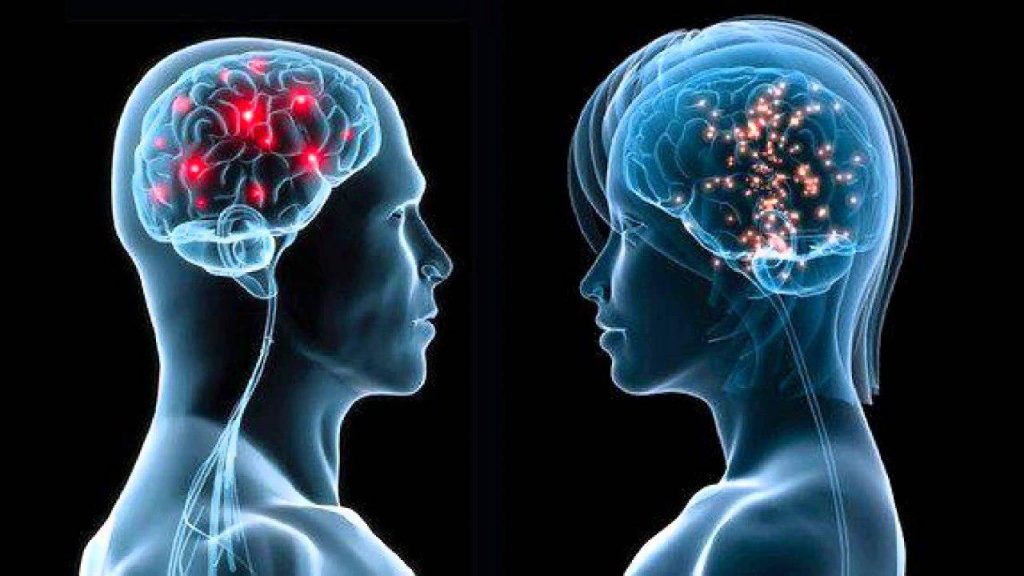تفاوت خصایص دو جنس زن و مرد
(از فصل آخر کتاب تکنیک رهایی ذهن)
•مرد می خواهد تنها باشد و مشکلش را خودش حل کند.
•زن همدرد می خواهد و نمی خواهد تنها باشد.
•مرد می خواهد از نظر همسرش قهرمان باشد.
•زن می خواهد شوهرش بداند که به او تکیه کرده است.
•مرد از وقت گذراندن بیش از حد همسرش با فرزندان حسودی می کند.
•زن از وقت گذرانی همسرش با بچه ها لذت میبرد.
•مرد گمان می کند اگر یک بار گفت “دوستت دارم” این برای همیشه در خاطر زن میماند.
•زن نیاز دارد که “دوستت دارم” به هر دلیلی تکرار شود.
•مرد نیاز به دادن عشق دارد.
•زن نیاز به دریافت کردن عشق دارد.
•مرد عاشق دیدن خوشحالی زن است.
•زن با دیدن خوشحالی زیاد مرد به تفّکر فرو میرود.
•مرد دوست دارد تشویق بشود و زن دوست دارد حمایت بشود.
•مرد نیاز به فضا دارد و زن نیاز به نزدیک شدن.
•ناراحتی زن احساس مفید نبودن به مرد میدهد.
•ناراحتی مرد به زن احساس دوست نداشته شدن میدهد.
•مرد در سکوت فکر می کند و فقط جملات ضروری را بیان می کند.
•زن با صدای بلند تمامی افکارش را بیان می کند.
چکیده ای از کتاب تکنیک رهایی ذهن
مرجع: کاریزما مشاور





To find clues for healthy living today, we must look to our past. The history of human evolution shows a definitive link between our physical health and psychological well-being. The Greeks understood the importance of a Sound Mind in a Sound Body. That credo became the foundation of their civilization. For clues on how we can best survive the 21st century we should look to the wisdom held in our ancestry and evolutionary biology.
In this entry I will explore ways in which modern living is causing our bodies and minds to short-circuit. I will recap the major periods of human evolution and offer a simple prescriptive that can insulate you from the ‘future shock’ that rapid advances in technology have created in our bodies, minds, and society. “Future shock” is a term for a certain psychological state of individuals and entire societies, introduced by Alvin Toffler in his book of the same name. Toffler’s most basic definition of future shock is: “ too much change in too short a period of time.” Do you feel future shocked? What ways are you coping with it?
The ۷ Habits for a Healthy Mind in a Healthy body are simple daily lifestyle choices. These 7 principles are the foundation of The Athlete’s Way philosophy:
۷ HABITS FOR A HEALTHY MIND IN A HEALTHY BODY
Technology vs. Evolutionary Biology
A visual image that I find useful for putting human evolution in perspective is to picture that if the entire length of your arm represented human evolution, the past 200 years would be represented by the white tip of a freshly clipped finger nail. We often forget the lightning speed with which recent modern inventions have reshaped our lives after hundreds of millions of years of very gradual change.
Here is a quick timeline of major inventions that have changed our lives since the 1800s: The steam engine and locomotive were invented in 1804, the telephone in 1876, the first electrical power plant in 1882, the production-line automobile in 1902, the television in 1927, the jet airplane 1943, the ATM in 1967, the cell phone in 1973, the internet in 1983. Isn’t it amazing to realize how recently these changes have occurred considering the first primate fossils date back some 20 million years?
The first seeds of the information age began in 1888 when an American inventor, Herman Hollerith, developed a successful computer, using punched cards and electricity. In 1911 he sold his company, the Tabulating Machine Company, which then became the Computing-Tabulating-Recording Company. In 1924 this company became IBM. Analog computers were developed in 1930 and the first electronic computer was in use by 1946.
The digital revolution was officially born late in 1947 when two Bell Labs scientists demonstrated a transistor that could take electric current, amplify it, and switch it on and off. By the late 1960s, large companies used computers. Personal computers were introduced in 1975. The internet and social media have changed the way we live, work and communicate in ways that would have seemed unimaginable just a decade پیش. We are all scrambling to keep our bearings in this digital whirlwind.
Like many people, I believe that we have to be proactive in order to combat the potential of digital technology to zap our minds and bodies of their vitality. Obviously, digital advances have improved our lives in so many ways, but there are so many uncertains. For example: As a parent, I wonder if iPads as a learning tool help raise a generation that is being spoon fed too much over-processed everything or do they enhance learning and creativity? I think it’s a dual-edged sword.
Technology has the ability to greatly enhance our lives, but it also has the power to cause our bodies and brains to atrophy. What are the consequences to our biology of living in a virtual reality, where we don’t have to work physically to stay alive? Will our children be able to adapt to these changes better than we did or will it only get worse? The advice herein is a prophylaxis to help insulate your biology so you can continue to climb ever-higher and maximize the potential of your body and mind.
Humans are Built to Run
As hunter-gatherers, the human body evolved to run great distances hunting prey and gathering food. The ability to spring through the air using our gluteus maximus muscles is what sets us apart from primate cousins. This pogo-stick ability of each leg allowed us to travel long distances and to hunt and gather a high protein diet, using relatively little fuel. We are very fuel-efficient machines. As our brains grew, so did our prefrontal cortex, the seat of human intelligence, and we became better hunters. It also kept our cerebellum bulked up, which gave us the benefit of a strong ‘up brain’ and a strong ‘down brain.’ I wrote a Pyschology Today blog about this split-brain model that you can check out here.
Endurance running is unique to homo sapiens among all other mammals except for dogs, horses and hyenas. Drs. Lieberman and Bramble, paleontologists at Harvard, established that our slender legs, shorter arms, narrower rib cage and pelvis, skulls with overheating prevention features, and the nuchal joint, which keeps our heads steady when we run, set us apart from chimpanzees.
The scientists concluded that running improved our chances of survival and reproduction. Although we were not as swift as our four-legged competitors, we could (and still can) out run and hunt over greater distances than other predators. Lieberman says, “Endurance running may have made possible a diet rich in fats and proteins thought to account for the unique human combination of large bodies, small guts, big brains, and small teeth.” It also imbedded the need to stay active into our biology.
Unity, Creativity, and Adventure are in Our DNA
One reason the Neanderthals may have became extinct is that they stayed in certain caves in France and parts of Spain for endless generations, relying on the same simple chiseled tools. Homo sapiens, on the other hand, were inclined to keep pushing into new areas, and inventing new technology. This is believed to be one reason that human lineage did not become extinct.
The first jewelry that archeologists have discovered dates back as far as 75,000 years پیش. It is believed that homo sapiens in Africa began making beads, and piercing holes in the teeth of deceased loved ones to wear as adornment around this time. These findings illustrate that creativity and a deep need for human connection are embedded in our DNA. As the hunter-gatherers traveled the land in small bands, they also made sharp spears and other tools. Creative thinking and innovation have been linked to human survival for millennia.
Early agriculturists faced many challenges that hunting-gatherers didn’t have to deal with. Farming meant the agriculturists needed to figure out how to exploit a relatively small amount of land very intensely, rather than taking advantage of a large amount of land as hunter-gatherers did. Early agricultural life, didn’t require us to run, but it did require superior intelligence, physical stamina, and close-knit human bonds. Humans were able to do this and continued to evolve.
Agrarian society created a new lifestyle and social network. Pre-industrial farming required intense physical labor. The harvest cycle required a sustained physical effort a few times of the year based on seasonal weather patterns. Just as hunter-gatherers traveled in bands together, agrarian farming built tight communities. The necessities of agrarian life molded human behavior and society in ways that were uprooted by industrialization and commercialized farming.
Early farmers had to store food and to refrain from consuming whatever was available at the moment. If an agricultural community behaved like hunter-gatherers by grazing as they gathered food, they would starve to death in the winter. As agrarians we had to practice delaying gratification and not feast when there was abundance. Given the abundance of calorie-dense, nutritionally low food constantly at our disposal today—and the innate hunter-gatherer wiring embedded in our biology—it is understandable why so many people binge and have trouble delaying gratification.
Industrialization + Energy Gluttony = Global Warming
The first Industrial revolution occurred in Great Britain between 1750 and 1830. The use of automated machinery and the arrival of mass production created a new consumersociety in the late 18th Century. Industrialization was a shock to the human system. Developments in Europe moved the population from a largely rural population, that made its livelihood from agriculture, to a town-centered society increasingly engaged in factory manufacturing. Later in the 19th century, similar revolutionary transformations began occurring in the United States.
Homo sapiens evolved to be very fuel-efficient machines. This is one reason it’s so easy for us to gain weight when we don’t have to do physical work to hunt or harvest our food. With industrialization, physical expenditure dropped drastically. A typical hunter-gatherer required only 2,000 to 5,000 kilocalories of energy a day obtained through direct caloric consumption. Early agricultural societies required the equivalent of 20,000 kilocalories per person daily to maintain a farm. Early industrial societies required 60,000 kilocalories worth of energy, and modern post-industrial information societies require the equivalent of 120,000 kilocalories. The impact of this energy consumption on our environment are well known and one reason voluntary simplicity will benefit us all in the long run.
Socio-Economic Stratification
With industrialization, people moved into cities and began to work in factories. The human relationship to physicality and to nature changed. Much of the Romantic movements of the 19th century were a reaction to industrialism, by a class of people who could afford to appreciate nature and translate it into art. The Romantics wanted to reconnect with nature for creative and spiritual reasons. They realized that in gaining a command over nature, humans had lost something visceral and mystical that occurred through a connection to nature. How is the disconnect from nature and our own biology impacting our spiritual connectedness today?
I decided to embrace voluntary simplicity and live closer to nature a few years پیش. Getting out of the city and de-cluttering my life was the most liberating thing I’ve ever done. Today I can fit all of my material possesions in the back of a small station wپیشn, and I wouldn’t have it any other way. I keep the overhead very low and am able to live by the 7 principles here on a spartan budget. You can, too! One great thing about the digital age is that it allows you to work from anywhere. I have chosen to live closer to nature with visits to the city. I find that it is the perfect balance for optimal creativity and well-being. I feel very lucky to have the best of both worlds.
The socio-economic stratification of those who make a living doing creative jobs and who also exercise regularly is a point of interest to me. When I look at the record number of high-achievers entering local road running races, marathons, triathlons…and compare those statistics to the nationwide averages of obesity, I ask myself the chicken-or-the-egg question of which came first: their creative success or their dedication to regular physical activity? I fear that exercise, obesity, and creativity will become more and more of a class-divider in years to come. I am working to combat this through everything I do with The Athlete’s Way platform and corporate partnerships geared at funneling resources towards wellness initiatives aimed at underserved American youth.
Conclusion: Sweat is the Most Effective Elixir for Future Shock
I strongly believe that the 7 Habits for a Healthy Mind in a Healthy Body presented here are an antidote for future shock. Adopting these habits into your daily routine will keep you healthy, happy, and young at heart. Daily physical activity is ultimately the single most important elixir for staving off the negative impacts of modern life. Just 20 minutes most days of physical activity makes a huge difference in your state of well-being.
As Hippocrates said, “Walking is the best medicine.” A short, brisk daily walk could make all the difference in your long-term mental and physical health. If you want to be a resilientthought leader or innovator, you need to flex muscles in your mind and your body. Physical activity clears the cobwebs from your mind and makes you more creative. Almost every successful person I know who has an enduring career and remains prolific with fresh ideas has made the connection that regular physical activity is a requisite for his or her mental, physical, and professional longevity.
You don’t have to become an exercise fanatic, but nobody can sweat for you. If you want to stay competitive in a modern world you have to make physical activity a part of your daily routine. A generation پیش before the digital revolution, in accepting his 1950 Nobel Prize in Literature Bertrand Russell—who was a zealot for the power of physical activity—addressed the pitfalls of modern living and offered some advice. I close with a quote from his speech titled: What Desires are Politically Important?